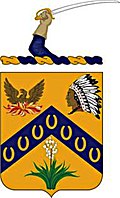7th Cavalry Regiment (United States)
| 7th Cavalry | |
|---|---|

7th Cavalry coat of arms
|
|
| Active | 1866 – present |
| Country |
|
| Branch |
|
| Type | Armored cavalry |
| Garrison/HQ | Fort Hood - Texas |
| Nickname(s) | "Garryowen" |
| Motto(s) | "The Seventh First" |
| March | Garryowen |
| Engagements | |
| Commanders | |
| Notable commanders |
Lt. Col. George A. Custer |
| Insignia | |
| Distinctive unit insignia |  |
| Regimental march | |
| U.S. Cavalry Regiments | |
|---|---|
| Previous | Next |
| 6th Cavalry Regiment | 8th Cavalry Regiment |
Lt. Col. George A. Custer
Col. (later Maj. Gen.) James W. Forsyth
Lt. Gen. Hal Moore
The 7th Cavalry Regiment is a United States Army cavalry regiment formed in 1866. Its official nickname is "Garryowen", after the Irish air "Garryowen" that was adopted as its march tune.
Following its activation, the Seventh Cavalry Regiment patrolled the Western plains for raiding Native Americans and to protect the westward movement of pioneers. From 1866 to 1881, the regiment marched a total of 181,692 miles (292,342 km) across Kansas, Montana, and the Dakota Territories.
The regiment was constituted on 28 July 1866 in the regular army as the 7th United States Cavalry. It was organized on 21 September 1866 at Fort Riley, Kansas as part of an expansion of the regular army following the demobilization of the wartime volunteer and draft forces. From 1866 through 1871, the regiment was posted to Fort Riley and fought in the American Indian Wars.
In the Battle of the Washita in 1868, the regiment sustained 22 losses, while inflicting more that 150 deaths on a Cheyenne encampment, mostly women and children. This attack was led by George Armstrong Custer, who later led the 7th Cavalry to the most calamitous defeat of U.S. forces in the Indian Wars.
Typical of post-Civil War cavalry regiments, the 7th Cavalry was organized as a twelve-company regiment without a formal battalion organization. Battalions at this time were flexible tactical organizations, with companies being assigned and removed as the field commander desired or felt necessary. Throughout this period, the cavalryman was armed with the Colt Single Action Army .45 caliber revolvers and trapdoor Springfield carbines, caliber .45–55 until 1892. The regiment used the McClellan saddle, and sabres were also issued but not often carried on campaign.
...
Wikipedia
